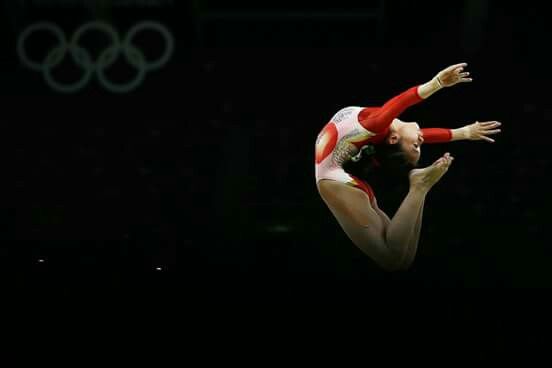The “Dead Loop”, also known as the “Korbut Flip”, is a gymnastics move that was banned from competition due to safety concerns. It involves:
- Standing on the high bar.
- Performing a backflip.
- Grasping the bar again to continue swinging.
This move was first performed by Olga Korbut at the 1972 Olympics and became popular for its innovative and dynamic nature. However, the high risk of injury, particularly neck and spine injuries, led to its prohibition in competitive routines.
Despite the ban, the “Dead Loop” remains a part of gymnastics history, marking a shift towards more acrobatic and dynamic routines in the sport.
Understanding the Dead Loop
To truly appreciate the Dead Loop, it’s essential to delve into the history and mechanics of gymnastics itself. Gymnastics originated in ancient Greece, where it was practiced for both physical conditioning and entertainment. Over centuries, it has transformed into a highly specialized sport with various disciplines and events. Read about What Comes After Level 10 Gymnastics

History and Evolution of Gymnastics
Gymnastics has a rich history dating back thousands of years. Initially, it was part of military training and later became a staple in Greek education. Modern gymnastics as we know it today began to take shape in the 19th century, with the establishment of formalized gymnastics schools and competitions.
Techniques Involved in Gymnastics
Gymnastics encompasses a wide range of techniques, including flips, twists, balances, and rotations. Athletes train rigorously to master these skills, combining strength, flexibility, and agility to execute flawless routines.
Types of Gymnastics
Gymnastics is divided into several disciplines, each with its own unique set of rules and apparatus:
- Artistic Gymnastics: Involves performing routines on apparatus such as the balance beam, uneven bars, vault, and floor exercise.
- Rhythmic Gymnastics: Focuses on graceful, choreographed routines with props like ribbons, hoops, and balls.
- Trampoline Gymnastics: Features high-flying routines performed on a trampoline.
- Acrobatic Gymnastics: Emphasizes teamwork and precision, with athletes performing dynamic acrobatic routines. Discover about What is a DS in Volleyball
What is the Dead Loop?
The Dead Loop is a breathtaking maneuver that epitomizes the skill and athleticism of gymnasts. It involves a combination of flips and rotations performed in mid-air, culminating in a perfect landing.
Definition and Explanation
The Dead Loop, also known as the “Double Back Full Twist,” is characterized by its complexity and precision. It requires the gymnast to execute two backward somersaults while simultaneously twisting their body 360 degrees.
Mechanics of the Dead Loop
Executing a Dead Loop requires exceptional strength, timing, and spatial awareness. The gymnast launches themselves into the air, tucking their body into a tight ball while initiating the first somersault. As they complete the first rotation, they begin to untwist while initiating the second somersault and twist simultaneously. The goal is to achieve maximum height and rotation while maintaining control throughout the maneuver.
Variations and Styles
While the basic mechanics of the Dead Loop remain consistent, gymnasts often incorporate variations and personal flair into their performances. Some may add extra twists or combine the Dead Loop with other maneuvers to create more complex routines. Learn about How Long is a Football Game
Importance of the Dead Loop in Gymnastics
The Dead Loop serves as a testament to the athleticism and artistry of gymnasts. Its inclusion in routines adds excitement and difficulty, pushing athletes to continually push their limits and innovate.
Training and Preparation for Performing Dead Loops
Mastering the Dead Loop requires years of dedicated training and practice. Gymnasts undergo rigorous physical conditioning to build strength, flexibility, and endurance. They also work closely with coaches to perfect their technique and fine-tune their routines.
Safety Measures in Gymnastics
Safety is paramount in gymnastics, especially when performing high-risk maneuvers like the Dead Loop. Athletes are trained to execute proper technique and landings to minimize the risk of injury. Coaches and spotters play a crucial role in ensuring the safety of gymnasts during training and competitions.
Common Injuries Associated with Gymnastics
Despite precautions, gymnastics carries inherent risks, and injuries are not uncommon. Common gymnastics injuries include sprains, strains, fractures, and overuse injuries. Proper warm-up, stretching, and conditioning can help mitigate the risk of injury.

Benefits of Gymnastics
Beyond its physical challenges, gymnastics offers numerous benefits, including improved strength, flexibility, coordination, and mental discipline. It fosters teamwork, perseverance, and self-confidence, instilling valuable life skills that extend beyond the gym.
Famous Gymnasts Known for Dead Loops
Throughout history, many gymnasts have made their mark with jaw-dropping performances featuring the Dead Loop. Names like Simone Biles, Kohei Uchimura, and Nadia Comăneci are synonymous with excellence in gymnastics.
Challenges and Risks in Performing Dead Loops
While the Dead Loop is a spectacular feat, it is not without its challenges and risks. Gymnasts must contend with factors like fatigue, pressure, and competition nerves, which can impact performance and safety.
Future Trends in Gymnastics
As gymnastics continues to evolve, we can expect to see further innovation and progression in technique, equipment, and training methods. The sport will undoubtedly continue to captivate audiences worldwide with its dazzling displays of athleticism and artistry.
Conclusion
In conclusion, the Dead Loop represents the pinnacle of skill and athleticism in gymnastics. Its execution requires precision, strength, and artistry, making it a defining moment in any gymnast’s career. As the sport of gymnastics continues to thrive and evolve, the Dead Loop remains a timeless symbol of excellence and achievement.
FAQs
- Is the Dead Loop Dangerous?
- Performing the Dead Loop carries inherent risks, but with proper training and technique, gymnasts can minimize the risk of injury.
- How Long Does it Take to Learn the Dead Loop?
- Mastering the Dead Loop requires years of dedicated training and practice, depending on the individual’s skill level and athleticism.
- What Are Some Tips for Performing the Dead Loop?
- Focus on building strength, flexibility, and technique. Work closely with coaches to refine your skills and perfect your routine.
- Can Anyone Learn to Perform the Dead Loop?
- While the Dead Loop is a challenging maneuver, with dedication and perseverance, many gymnasts can learn to perform it safely and effectively.
- What Makes the Dead Loop So Impressive?
- The Dead Loop showcases the perfect blend of athleticism, precision, and artistry, making it a highlight of gymnastics routines worldwide.







